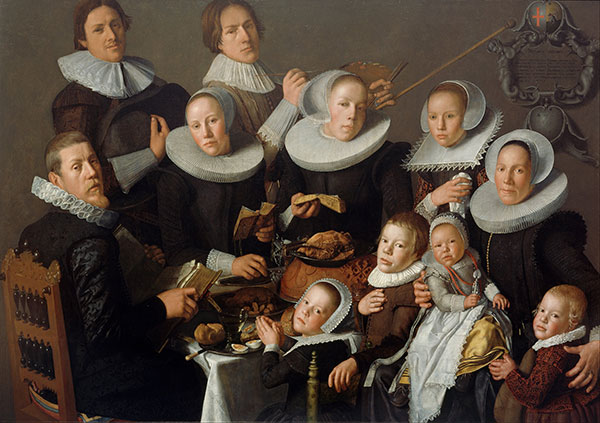Presbyterian records
Published in Features, Issue 1 (January/February 2018), Volume 26(including Covenanters & Seceders)
By Fiona Fitzsimons

Above: Portrait of the Dutch painter Andries van Bochoven (1609–34) and his family. In the seventeenth century there was a network of dissent, spanning Ireland, Britain (especially Scotland), the Netherlands and latterly North America.(Central Museum, Utrecht)
Historically, Irish dissent was dominated by Presbyterianism. Even before the Confederate Wars of the 1640s Presbyterianism had set down deep roots in Ireland. For the remainder of the century the authorities tolerated Presbyterian dissent. The 1662 ‘Act to Incourage Protestant Strangers… to inhabit … in the Kingdom of Ireland’opened Dublin’s guildsto members of all reformed Protestant churches. But in the eighteenth century Presbyterianism was undermined by emigration to the Americas. In 1725 there was a rift between those congregations that subscribed to the those that chose not to. The subsequent schism shaped the political and religious identity of Ulster Presbyterians. The theological rift was only finally resolved in 1840, with the formation of the General Assembly of the Presbyterian Church in Ireland. The earliest surviving Presbyterian registers date from the late seventeenth century, but these are rare survivals. Most of the registers only start in 1819 when, at a synod of the Presbyterian Church, ministers were instructed to keep registers of baptisms and marriages. For the seventeenth and eighteenth centuries Presbyterians can be found in the Church of Ireland registers.
Presbyterian records are recorded in English, with an economy of language.
Baptisms
The registers record the date of birth, date of baptism, child’s name, the father’s name and (supposedly) the place of residence.
Marriages
The registers record the date of marriage, the name of the bride and groom, whether married by banns or by licence, and usually the name of the bride’s father.After 1819 the name of the groom’s father is more often recorded, along with the names of two witnesses, and the bride and groom’s place of residence. After 1845 the information recorded in the civil marriage record usually corresponds to the church marriage registers.
Burials
By the 1840s Presbyterians began to maintain their own burial grounds.Registers often only record the name of the deceased person and their age at death. Some individual meetings kept lists of ‘deaths’, which occasionally pre-date the 1840s, but these are rare.
Guide to the records
Dissenters organised themselves by congregations or ‘meetings’ around a minister. As ministers moved, and meetings merged or split, the registers might move far from the district. So although the very strength of the dissenter church is in its organic structure, this can create headaches for family historians trying to trace the records.
The Public Record Office of Northern Ireland (PRONI) has collected and microfilmed almost all Presbyterian registers in the historic province of Ulster, and many in the Republic of Ireland. Not surprisingly, coverage in Northern Ireland and the border counties is more complete than in the Republic. The guide describes the type of records that survive and the time-frame covered (e.g. baptisms 1827–67; lists of elders 1815–72; removals, including emigration, 1804–44; session minutes 1760–1818). A small number of parish records remain in local custody,https://www.nidirect.gov.uk/sites/default/files/publications/Guide_to_church_records.pdf, or in the Presbyterian Historical Society, Belfast, www.presbyterianhistoryireland.com/. In the Republic of Ireland, registers are usually held locally by the minister.
















